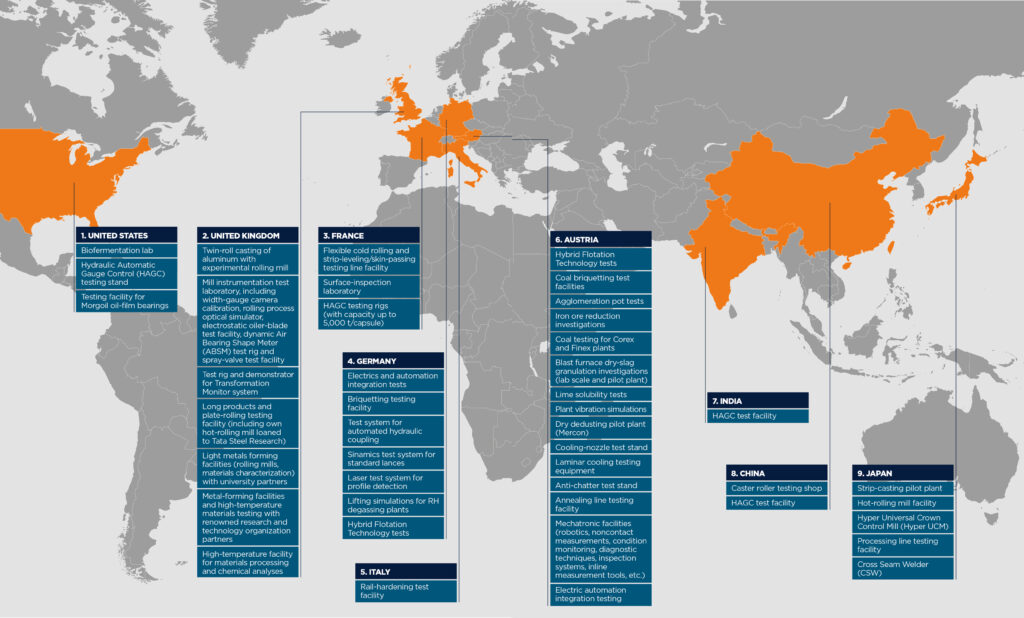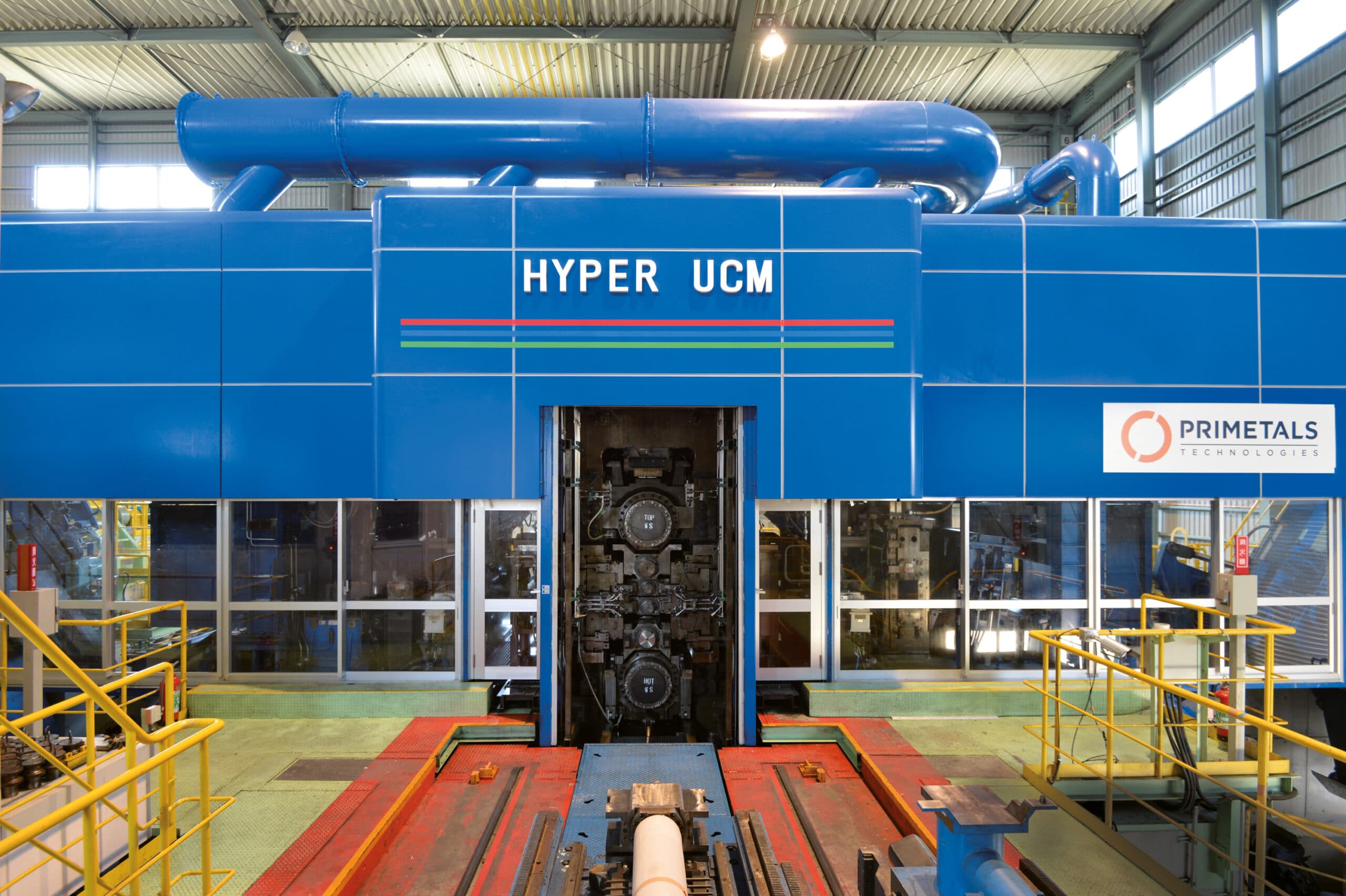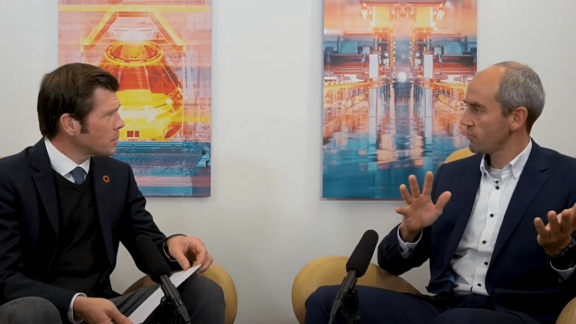This post is also available in: 简体中文 (Chinese (Simplified))
As a world-leading engineering and plant-building enterprise for the metals industry, Primetals Technologies places the highest priority on ensuring that all supplied plants, equipment, and technology are fully proven and meet contract specifications and project requirements. To this end, the company – together with its cooperation partners – has at its disposal some 60 well-equipped testing and optimization facilities located at 23 sites worldwide. All steps of the iron and steel production route as well as nonferrous technologies are covered.

cooperation partners
Before a technical product can be useful to industry, certain attributes have to be met and proven. A product needs to perform repeatedly. It must withstand the environmental conditions in which it operates for as long as possible. New equipment and components require exhaustive testing and certification to ensure that they are reliable and safe to use. Testing is fundamental to engineering. It does not just apply to a final product ready for dispatch to a customer, but also encompasses the integration of product systems. Testing covers all stages in the development of a technology as well as all stages of manufacturing.
Primetals Technologies is involved with complex engineering tasks on a daily basis. Testing is a cornerstone for much of the company’s business, from proving performance to assuring the quality of supplied equipment and plants. Testing is needed to optimize a process and to find out how well new concepts actually work. The expertise that is required to test a complex engineering system, such as a steelmaking converter, a rolling mill or processing facility, is very broad and highly diverse. The test equipment itself is often customized and usually expensive. All of this leads to the requirement for a cooperative approach to testing in which in-house facilities are combined with those of external partners.
The overriding goals include the development of new technologies; optimization of metallurgical processes; confirmation of the functionality, efficiency, practicality and economy of new equipment designs; and the flawless integration of all associated electronic, mechatronic, automation and environmental systems. In the following, the numerous optimization and testing facilities that are at the disposal of Primetals Technologies are reviewed (Figure 1). These extend across the entire metals value chain, from ore beneficiation facilities to the processed metal product.

Ironmaking Testing Facilities
Investigations related to the processing of carbon-bearing materials, ore treatment, product improvements and the suitability of refractory materials are carried out in the area of ironmaking. This includes ore flotation tests; iron ore reduction tests; and cold briquetting of coals, ores, sinter fines, pellet fines and sludges for subsequent use in metallurgical facilities (Figures 2–6).
Hybrid Flotation Technology:
The efficiency of the flotation process has a decisive impact on the profitability of a mine. Primetals Technologies introduced so-called Hybrid Flotation Technology, which is based on the combination of 1) pneumatic injection of an ore slurry into the upper zone of a flotation cell for fine and ultrafine ore-particle separation and recovery, and 2) air injection into the lower portion of a flotation cell for coarse ore-particle separation and recovery.
In a Hybrid Flotation Technology testing rig of Primetals Technologies, process aspects and design features are investigated and optimized to achieve a more efficient concentration of metals from sulfidic ores. A reverse flotation process can also be applied using the testing facility for silica removal from iron ore. The unit has a volume of 30 l and a throughput capacity of 0.72 m³/h. It is well suited for a quick evaluation of various ores, flotation chemistry, process parameters and flotation cell design.
Agglomeration pot tests:
The new pellet pot test facility of Primetals Technologies was built and commissioned in Leoben, Austria, at ARP (Aufbereitung, Recycling, Prüftechnik) Ges.m.b.H. in 2015. This facility allows fast and comprehensive testing of various pellet-feed mixtures and/or concentrates to determine their suitability for use in the pelletizing process (for more information read about the “future of pelleitzing,” here). In combination with beneficiation tests, calculations and CFD simulations, an optimum induration machine design can be engineered. Furthermore, fundamental research on material and process behavior can be performed using this fully automated agglomeration pot test facility.
Sinter pot tests are also conducted at the R&D facilities of voestalpine Stahl Linz, including the preparation of raw materials for the Intensive Mixing and Granulation System (IMGS). Furthermore, Selective Waste Gas Recirculation (SWGR) tests are carried out to determine the ideal selection of recirculation windboxes used in the SWGR process. Full chemical and physical analyses are done to optimize the sinter raw mix recipe and process parameters.
Blast furnace dry-slag granulation:
The feasibility of recovering the heat energy of liquid blast furnace slag for the generation of steam and electricity will be determined in a prototype dry-slag granulation plant (DSG) that is currently being installed on an industrial scale at the voestalpine steelworks in Linz. Previous DSG test were successfully performed on a laboratory scale with cooperation partners at the University of Leoben, Austria.

Converter steelmaking
Lime solubility tests can be carried out when lime is added to converter slag. These tests show how quickly lime is dissolved with different slag compositions. The tests have the purpose of more accurately determining the dynamic behavior of the converter process and better predicting the end of the oxygen-blowing phase in LD (BOF) steelmaking.
Simulations are also performed at Johannes Kepler University (JKU) in Linz related to the vibration behavior of AOD stainless steelmaking converters. On the basis of these results, a hydraulic vibration damper was developed to suppress AOD converter vibrations. This unit was installed and is now successfully operating at Taiyuan Iron and Steel Corp. (TISCO). A subsequent order was received from North American Stainless for a similar AOD converter vibration- damping system in September 2015.
Mercon:
A new dry-type converter offgas dedusting system is currently being developed jointly with a European steel producer (Figure 7). The dedusting system is referred to as Mercon, which is an acronym for maximized emission reduction and energy recovery in converter steelmaking. An inert material is injected into the offgas stream to avoid the risk of dust reoxidation during the non-blowing phase. Investigations are being carried out to optimize the materials used in the advanced bag filters with respect to high- temperature stability and maximum gas-cleaning efficiency, especially with regard to ultra-fine particulates. Emission values of less than 5 mg/Nm³ are targeted.


Electric steelmaking
Primetals Technologies has at its disposal a pilot plant facility that is available for investigating the use of molten salt as an intermediate heat-storage media for thermal energy contained in the EAF offgas (Figure 8). The unit was exhaustively tested at Stahlwerk Thüringen, Germany, where key process parameters and suitable corrosive-resistant materials were determined. The heat energy released as the molten salt solidifies can be used for the generation of steam for energy savings. The pilot plant is now installed at the Technical University of Vienna, Austria, and it is available for further process optimization work in collaboration with potential customers.
At the Willstätt-Legelshurst site of Primetals Technologies Germany, numerous tests are underway to improve EAF and vacuum degassing equipment and processes. Examples of these include:
- Testing of a laser-based system for scrap-profile detection for use in automated scrap bucket loading
- Automated hydraulic coupling of the scrap bucket used in shaft-type EAFs
- Application of a Sinamics system for testing standard lances
- Vacuum degassing vessel-lifting simulations


Continuous casting
In the field of continuous casting, a strip-casting process for both steel and nonferrous metals is being further developed at the Hiroshima site of Primetals Technologies (Figure 9). Complementary processes for the strip casting of aluminum are under development at Brunel University in the U.K. Promising research results can be transferred to Hiroshima for in-house refinement of potential commercial technologies.
At the company’s nozzle testing stand in Linz, the design and control of nozzles used for the secondary cooling of the cast strand are continually being enhanced, and the complete nozzle characteristics are measured to fully optimize strand-cooling parameters (Figures 10–11).
Continuous casting trials and tests are performed at customer plant sites in order to investigate measures to increase the casting speed, improve product quality and optimize equipment design. Furthermore, the thermodynamic properties of different steel-grade compositions during the solidification process are measured in the laboratory at the University of Leoben, which extends the knowledge base of proprietary Level 2 process-control packages such as DynaPhase, Dynacs 3D and DynaGap 3D.
Long rolling
Primetals Technologies and the Italian technical center Centro Sviluppo Materiali (CSM) jointly developed the idRHa+ system for improving hardness distribution across rail crowns. This is especially important for heavy-haul and high-speed railways. idRHa+ was developed on the basis of thermal, mechanical and metallurgical models, which were validated by experimental trials conducted in an industrial pilot unit (Figure 12). This solution provides tailored inline cooling protocols that allow an accurate fine- pearlitic microstructure and hardness distribution across the rail crown to be achieved. idRHa+ rail-hardening technology was installed for the first time at the Baogang Rail Mill in Baotou, China.
Flat rolling
Hot-rolling tests, including welding trials, are performed in Hiroshima, Japan, on a small-size, 4-high hot-rolling mill with a rolling load capacity of 300 MN (Figure 13). Extensive tests related to the joining of transfer bars for continuous hot rolling are also carried out. In addition to further improving rolling parameters, design enhancements and trials using the so-called Mill Stabilizing Device (MSD) serve to minimize vibrations in the finishing train of hot-strip mills.
An experimental rolling mill owned by Primetals Technologies UK is currently in use at Tata Steel’s Swinden Technology Centre (Figure 14). The mill is shared by Tata Steel and Primetals Technologies to further improve the hot-rolling process. The R&D collaboration between a steel producer and technology supplier provides an ideal platform to develop, optimize and implement rolling mill solutions.
For the hot rolling of flat or long steel products, a universal technology is being researched under the direction of Primetals Technologies at the U.K. Universities of Manchester and Warwick to allow inline measurements of the transformed fraction and characterization of grain structure (size and texture) to be performed. In-house instrument testing and calibration for commercial use of this technology are conducted at the Christchurch, U.K., location of Primetals Technologies. Trials are underway at the voestalpine steelworks in Linz to achieve highly precise water-flow control in the laminar-cooling section of the company’s hot-strip mill. The target is to ensure that water flow is simultaneously turned on or off without post-flow or post-dripping, which is particularly important for special steel grades such as electrical steels. Furthermore, oil-film bearing tests as well as Hydraulic Automatic Gauge Control (HAGC) trials are done at various workshops and competence centers of Primetals Technologies (Figure 15).
Cold rolling
At the Hiroshima site of Primetals Technologies, a full-size, 6-high Hyper Universal Crown Control Mill (Hyper UCM) is installed to enable extensive cold-rolling tests and equipment optimization work to be executed. The mill includes an edge-drop control system that prevents excessive strip-thickness reduction at the strip-edge area, which is particularly important for advanced steel grades (Figure 16). Primetals Technologies also has a rolling testing facility in Montbrison, France, (Figure 17) where process parameters are examined and equipment improvements are implemented for improved rolling of different steel grades. The new Cross Seam Welder is also being further optimized for use in pickling and tandem cold-rolling lines, in particular for the welding of high-strength steels (Figure 18). Finally, on the anti-chatter test stand in Linz, the chatter phenomena in cold-rolling mills and various chatter- suppression solutions are studied.
Aluminum rolling
In the U.K., Primetals Technologies makes use of an electrostatic oiler test facility to evaluate and further develop different contract-specific electrostatic oiler blades. The test rig is very flexible and allows the spraying ability of a blade as well as the distribution of oil across the width of the product to be quantified and assured. It can also be used to verify that a customer’s oils are suitable for strip application using electrostatic methods (Figure 19).
Processing lines
Company testing and inspection facilities for strip processing are located in Montbrison, France (Figure 17); Hiroshima, Japan; and Linz, Austria (Figure 20). At these sites, key equipment components used in coating, annealing, surface quality monitoring and treatment are improved and optimized with the goal to find and develop the best solution for different applications and steel grades. Using these facilities saves time and costs in the development of new steel grades compared to trials on an industrial annealing or galvanizing line.
Mechatronics
State-of-the-art solutions for metals production processes are unthinkable today without mechatronic products. Primetals Technologies and its parent companies have the world’s largest staff of mechatronic specialists dedicated to improving metallurgical equipment, processes and results. Experienced specialists from different fields cooperate closely together to create optimized systems, from stand-alone measurement devices up to fully integrated mechatronic packages. The spectrum of solutions includes highly sophisticated robotic applications for dangerous areas of a steelworks – particularly where liquid metal is manipulated – noncontact measurement and inspection systems, offline simulations, condition monitoring and other diagnostic techniques, and inline measurement tools to determine the mechanical properties of steel strip. Mechatronic products substantially contribute to improvements in product quality, personnel and equipment safety, and environmental protection (Figure 21).

Automation
The proper functionality of electric, electronic, automation, and software packages are exhaustively tested at the automation competence centers of Primetals Technologies before they are supplied to customer production sites. In a first step, the tests are performed on discrete automation modules, and in a second step, integration tests are carried out to ensure the overall interfunctionality of the various automation packages and interfaces. In this way, on-site system start-up times are significantly reduced according to the principle of “connect & produce.”
Industry 4.0: Primetals Technologies is intensively working on the development and implementation of Industry 4.0 solutions in the steel industry. Equipment and machines within a plant complex are digitally networked with one another, and decisions regarding, for example, production planning or timely maintenance activities are automatically and independently made. Industry 4.0 will advance process optimization to a new level of sophistication with considerably reduced costs.
Eco solutions
LanzaTech and Primetals Technologies have signed an exclusive cooperation agreement to develop, optimize and market LanzaTech’s biofermentation process. This solution features microbial fermentation of carbon- and hydrogen- rich offgases such as coke oven gas, blast furnace top gas, direct-reduction gas and LD (BOF) converter gas to produce ethanol or other basic chemicals – accompanied by a major reduction in CO₂ emissions. Company tests related to the transformation of CO₂ into chemicals and fuels such as ethanol, 2.3–Butanediol and others by means of a bacteria culture are carried out at a purpose-built laboratory of LanzaTech in Skokie (near Chicago), Illinois, U.S.A. On the basis of the test results it will be possible to specify and optimize the respective equipment and process parameters for individual customer plants.
Quality control
Of course, the R&D solutions, processes and products developed in the R&D testing and optimization facilities of Primetals Technologies are subject to rigid and exhaustive quality-control investigations before they are marketed and installed for industrial application (Figure 24). Dedication to quality is a company commitment and an obligation.
Testing Facilities for the benefit of the customer
Cooperation with partners in the field of testing is not just a necessity borne of the expense of installing and using highly specialized facilities; it is also a platform for collaborative research, development and process improvements. It involves suppliers and customers, among which are some of the world’s most prestigious engineering organizations and metals producers. All areas of the value chain – extending from raw and input materials to the finished metal product – profit from such cooperations. Experience tells us that shared ideas are more viable and better aligned to real industrial needs. The path to their successful application is also shorter.
The R&D work carried out in the numerous testing and optimization facilities available to Primetals Technologies has one main objective – to develop, optimize and implement solutions that ultimately benefit our customers. This is the basis for viable, sustainable and competitive metals production, and for creating the future of metals as one. ●
The authors wish to express their gratitude to all joint-cooperation partners for the excellent collaboration and for making available their site-testing facilities, materials, equipment and staff of experts and specialists for numerous R&D projects.
















